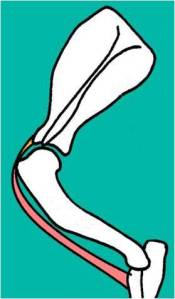The Elbow joint is formed between distal end of humerus (humeral condyle) and proximal ends of radius and ulna in both species. The articulations are the same in both species. The trochlea of the humerus is the largest area and is located medially with a central depression. On the lateral side, there is a smaller flatter area called the Capitulum. Radius and ulna fused in horse but separate in dog. Trochlea of humerus articulates with fovea capitis and trochlear notch and the Capitulum of humerus only articulates with fovea capitis.
Joint movements:
Flexion and extension possible in both dog and horse between humerus and radius/ulna.
Pronation and supination possible in dog due to rotation of radius relative to ulna but not horse.
The joint features are the same in both species:
The elbow is a typical synovial joint, with Hyaline cartilage on the joint surfaces- this smooths the surface to reduce friciton. The joint contains synovial fluid that nourishes the cartilage and lubricates the joint. This fluid is produced by the synovial membrane that supports the joint capsule when it thickens medially and laterally when it formes the collateral ligaments. The synovial membrane attaches around the edges of the articular cartilage and incorporates proximal articulations between radius and ulna.
To creat joint stability for the flexion and extension an anconeal process of the ulna sits in the olecranon /ulnar fossa of the humerus. This prevets lateral /medial movement when the joint is in extension. This is also why it is impossible to dislocate the joint unless it is in flexion. The collateral ligaments run from the humeral epicondles to radius and ulna, which also helps to limit the movement to flexion and extension. (this is very extensive in the horse). In the dog there is an annular ligament that runs from the medial to lateral coronoid processes of the ulna and encircles the radius allowing it to rotate during pronation and supranation. The annular ligament is absent in the horse.
Muscles – same in both species:
Flexion = reduction of angle cranial to joint. Motor nerve supply = musculocutaneous nerve. Biceps brachii. Origin = supraglenoid tubercle of scapula, Insertion = proximal radius. Brachialis muscle. Origin – humerus. Runs in musculospiral grove. Inserts proximal radius.
Extension (x2) = increase in angle cranial to joint. Motor nerve supply = radial nerve.
Triceps muscle with the 4 heads. Origins:
long head = caudal border of scapula,
lateral head = tricipital line on humerus,
medial head = medial aspect humerus and
accessory head = caudal aspect humerus.
Insertion = olecranon process of ulna.
The other extensor is the Anconeus Muscle (very small)
it has its origin on the dital humrus (olecranon fossa) & incerts onto the lateral aspect of the ulna.

The horse has a subcunateous bursa between the skin and tendon, and a tricipital busa between the tendon and the olecranon process. These are of clinical significance to the horse if it has poor bedding it can get capped elbow or bursitis (deep swelling).
The elbow rotators in the dog are:
Supinator muscle: Origin – lateral epicondyle.•Radial nerve
Pronator teres muscle: Origin – medial epicondyle •Median nerve
Both Incerts on the – proximal radius
The radial – extensor nerve arises from the brachial plexus. It starts medially and passes causal to the shoulder where is supplies the Triceps muscle and follows the musculospiral groove & brachialis muscle. It then runs to the lateral epicondyle and supplies the carpal and digital extensors in the dog.











Hi Annette
Thanks for such creating a great blog. I am studying Natural Animal Health in New Zealand and have found the information you have written to be quite useful in my own studies. Best of luck with your vet training!
Regards,
Angela
hi Annete………..!!!!!!!!
I m ashwini studing veternary in India. Ur notes realy helped me alot in exams I thnk nt evn me bt many students got help 4m dis. U r very kind. I wish u ll hav a very bright future. All the best n keep helping students like me.
with thanks,
Ashu
hi ashu, im suzana, vet student from malaysia.wish to know you better
thanks annete…………
Hej!
Du har möjligtvis inte någon förklaring av begrepp inom arthrology?
Tack för en bra sida 🙂
Hei Tina, beklager har ikke det =) takk
Hi. I’m a horse owner in Australia. My horse has a double-jointed action of both elbows, worse when going down-hill. Curious if you have ideas why & how it can be treated? Thanks for the great blog!
Unfortunately im unsure what you mean by double jointed action of the elbows. If in any doubt about the health of your animal you would need to be seen by your veterinarian